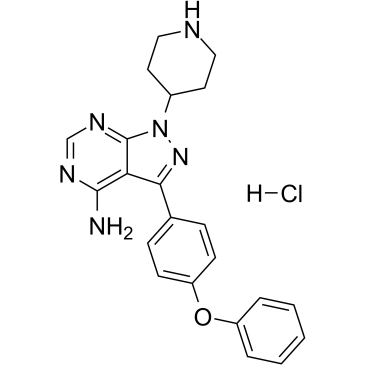N-piperidine Ibrutinib hydrochloride
Modify Date: 2025-08-26 18:50:06

N-piperidine Ibrutinib hydrochloride structure
|
Common Name | N-piperidine Ibrutinib hydrochloride | ||
|---|---|---|---|---|
| CAS Number | 2231747-18-3 | Molecular Weight | 422.91 | |
| Density | N/A | Boiling Point | N/A | |
| Molecular Formula | C22H23ClN6O | Melting Point | N/A | |
| MSDS | N/A | Flash Point | N/A | |
Use of N-piperidine Ibrutinib hydrochlorideN-piperidine Ibrutinib hydrochloride (Compound 1) is a reversible Ibrutinib derivative. N-piperidine Ibrutinib hydrochloride is a potent BTK inhibitor with IC50s of 51.0 and 30.7 nM for WT BTK and C481S BTK, respectively[1]. N-piperidine Ibrutinib hydrochloride can be used as a BTK ligand in the synthesis of a series of PROTACs, such as SJF620 (HY-133137). SJF620 is a potent PROTAC BTK degrader with a DC50 of 7.9 nM[2]. |
| Name | N-piperidine Ibrutinib hydrochloride |
|---|
| Description | N-piperidine Ibrutinib hydrochloride (Compound 1) is a reversible Ibrutinib derivative. N-piperidine Ibrutinib hydrochloride is a potent BTK inhibitor with IC50s of 51.0 and 30.7 nM for WT BTK and C481S BTK, respectively[1]. N-piperidine Ibrutinib hydrochloride can be used as a BTK ligand in the synthesis of a series of PROTACs, such as SJF620 (HY-133137). SJF620 is a potent PROTAC BTK degrader with a DC50 of 7.9 nM[2]. |
|---|---|
| Related Catalog | |
| Target |
IC50: 51.0 nM (WT BTK), 30.7 nM (C481S BTK)[1] |
| In Vitro | N-piperidine Ibrutinib hydrochloride can be used as a BTK ligand in the synthesis of a series of PROTACs. SJF638, SJF678, and SJF608 are potent PROTAC BTK degraders with DC50s of 374, 162, and 8.3 nM, respectively[2]. |
| References |
| Molecular Formula | C22H23ClN6O |
|---|---|
| Molecular Weight | 422.91 |
| InChIKey | ORBFZIXZKIUECG-UHFFFAOYSA-N |
| SMILES | Cl.Nc1ncnc2c1c(-c1ccc(Oc3ccccc3)cc1)nn2C1CCNCC1 |